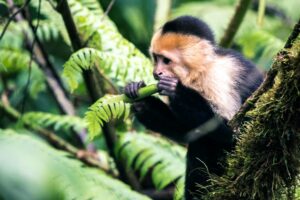Imagine. The day rises between Nosara and Tamarindo. Costa Rica is waking up around you. The green of nature is mixed with the blue of the sky and the rays of the sun. In the rainforest, nocturnal animals quietly give way to monkeys and other diurnal species. Listen to the screechings, cracking and cackles. Maybe you are surprised by some birds singings but this is a happy cacophony you can hear. But a cry prevails, a loud and impressive cry that seems to swing from tree to tree, as fast and effective as the wind. Immediately, your senses are activated, your attention is focused, you fear to meet a huge gorilla, as King Kong. But no ! The branches bend willingly, some black spots arrive, and here are charming little monkeys just in front of you. The howler monkey, also known as Alouatta palliata, is one of the 4 species of primates living in Costa Rica. Approaching howler monkeys in Costa Rica in its natural environment, a destination in its own right.
Approaching howler monkeys in Costa Rica | Let’s go to Guanacaste
4 species from Cebidae family live in Costa Rica :
- the white-faced capuchin monkey (Cebus capucinus) for its… white face ;
- the Central American spider monkey (Ateles geoffroyi or Ateles paniscus) owes its name to the length of its limbs ;
- the squirrel monkey or Sapajou (Saimiri oerstedii or Saimiri sciureus) for its tail as long as its body;
- the howler monkey (Alouatta palliata or Alouate) that interests us in this article.
The latter is, as its name suggests, howley monkeys, are recognizable by its cry. It is so loud that its echo resonates in the Guanacaste up to 4 km around. And, it is not a coincidence. He makes himself heard to prevent danger and mark his territory. He is at home in Guanacaste, in his natural environment and intends to stay there. Contrary to what its decibel power may suggest, the howler monkey only measures between 60 and 90 cm. It evolves in small groups, a dozen mammals form its tribe, mostly females. Drawing its food from the treetops, it rarely comes down.
Indeed, leaves and fruits are enough to compose his diet. Very used to meeting human beings, they show themselves early in the morning or in the late afternoon. Present throughout Costa Rica, the howler monkey mainly frequents the Pacific coast and the Guanacaste in particular. Here, it is an integral part of the daily landscape and having coffee in their company is an everyday privilege. From home, watch, admire and meet the Costa Rican howler monkeys.
Deforestation Impacts Alouate Cry
Trees | A territory and a source of food
To move, the howler monkey jumps from branch to branch. That’s why cutting down trees means cutting off his road and food. Human presence and uncontrolled agriculture negatively impact the native wild flora. A recent investigation by Laura Bolt, professor of anthropology, studies the sound of the cries according to anthropogenic deforestation. It turns out that the cry of the primate loses power on the edge of the forests, where food, fruits in particular, are becoming scarce. The higher the quality of the food, the louder and longer the males cry. This experiment corroborates the protective function of the howler monkey, or alouate in its biotope. By this signal, it defends his resources and warns its fellow beings of the presence of the meal already served.
Reforestation | The solution
Deforestation therefore has a direct impact on the survival of this species. According to this researcher and the newspaper phys.org, “ people tend to think that Costa Rica is a very green country with large tracts of forest. While this represents effective marketing for tourists, the reality is that Costa Rica is deforested in many regions.” Nevertheless, after the devastating 70s, Costa Rica has been working for more than 30 years to vegetate and combat deforestation. It is now a model for the rest of the world.
This is the reason why, at Los Nancites, we multiply ethical actions, to protect the environment, to bring adequate food and habitat to the howler monkey. Visibly pleased with our services, it is now our daily roommate to the delight of of our customers. Indeed, these little primates share with our guests a space of preserved tropical life. A perfect place to touch them, in all intimacy, with your eyes while respecting their freedom. Their natural environment also becomes yours, or vice versa, as you prefer !
Alouatta palliata | Vulnerable in its own natural environment
“Palliata”, for pallium which means coat in Latin : the howler monkeys wear a black fur with some orange shades on the back. However, since 2013, there is an increasing quantity of this breed of monkeys with bigger and bigger yellow shades. Mammalian Biology journal explains this pigmentation by the increasing number of melanocytes, a cell naturally present in the monkey’s body. Gustavo Gutiérrez-Espeleta’s team speaks about a higher carnation near areas of intensive pesticide use, such as pineapple, banana or palm fields. The correlation remains to be proven, but the consequence is real. This discoloration makes the howler monkey easier to spot for raptors and other predators living in its natural environment.
Convinced that it is urgent to protect and promote wildlife in its own territory, at Los Nancites, we create the ideal living space for humans, animals and the ecosystem. Staying in our lodges, studios or villas contributes to finance local reforestation programs. For you, nothing to do but take a vacation and enjoy these magical moments that our paradise close to Playa negra, in the province of Guanacaste, offers to you. Maybe you could lend an ear while drinking your morning coffee, but no, not even ! You understand it, we do not escape from the scream of the howler monkey.
Like this adventure in a Costa Rica as you will never see it elsewhere ? Just contact us to approach the howler monkeys in their natural environment.

Sources :
phys.org — Studies about déforestation
phys.org — Le cri des singes hurleurs


